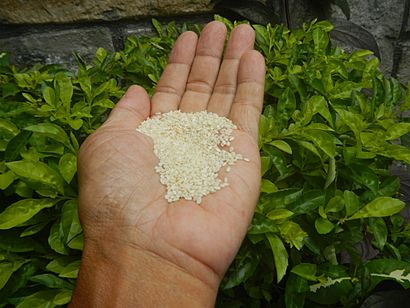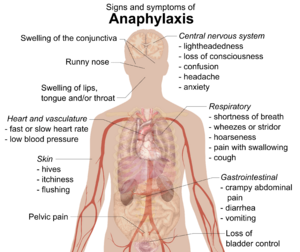Sesame allergy facts for kids
Quick facts for kids Sesame allergy |
|
|---|---|
 |
|
| Raw sesame seeds with sesame plants in background | |
| Pronunciation |
|
| Symptoms | itchiness, rash, swelling of lips, tongue or the whole face, eczema, wheezing and shortness of breath, nausea, vomiting, abdominal pain, diarrhea, anaphylaxis |
| Causes | Type I hypersensitivity |
| Risk factors | Childhood in Middle East, where sesame is a traditional food, and increasingly in developed countries |
| Diagnostic method | Medical history and standard allergy tests |
| Similar conditions | Peanut allergy, Tree nut allergy |
| Prevention | Introduction to allergenic foods during infancy |
| Treatment | Epinephrine Antihistamines (mild) |
| Prognosis | 70% to 80% persist into adulthood |
| Frequency | 0.1–0.2% (higher in Middle East countries) |
Sesame allergy is when your body reacts badly to foods that have sesame seeds. It's a common food allergy. About 0.1% to 0.2% of people have this allergy. It's more common in places like the Middle East where sesame is a big part of their food.
More people are reporting sesame allergies now. This might be because more foods contain sesame, or because people know more about allergies. Because of this, many countries now require food companies to clearly label if their products have sesame. In the United States, sesame became the ninth food ingredient that must be labeled on January 1, 2023.
An allergic reaction happens when your body's defense system, called the immune system, overreacts to certain proteins in sesame seeds. This includes foods and even some sesame oil. Symptoms can show up quickly, within minutes, or slowly, over hours or days. A fast and serious reaction is called anaphylaxis. This can be life-threatening and needs quick treatment with a medicine called epinephrine. Other slower reactions might include skin rashes or inflammation in the throat.
Many countries require food labels to show if a product contains sesame. This is in addition to the eight most common food allergens. These are milk, eggs, wheat, shellfish, peanuts, tree nuts, fish, and soy beans. Unlike allergies to milk and eggs, which often get better as kids grow up, sesame allergy usually lasts into adulthood. About 70% to 80% of people with sesame allergy will have it for life.
Contents
What Are the Signs of Sesame Allergy?
When someone has a food allergy, symptoms usually appear quickly. This can be from a few minutes to a few hours after eating the food.
Common signs of a sesame allergy include:
- Itchy skin, mouth, lips, tongue, or eyes.
- Rashes or hives (itchy red bumps on the skin).
- Swelling of the lips, tongue, eyelids, or face.
- Trouble swallowing.
- A runny or stuffy nose.
- A hoarse voice.
- Wheezing or shortness of breath.
- Stomach pain, diarrhea, nausea, or vomiting.
- Feeling dizzy or faint.
Some reactions are not as severe and happen hours or days later. Symptoms can be different for each person and each time a reaction happens.
When an Allergic Reaction Becomes Serious
A very serious allergic reaction is called anaphylaxis. This can be life-threatening. It causes breathing problems like wheezing and difficulty breathing. It can also affect blood flow, leading to a weak pulse, pale skin, and fainting. This happens when special IgE antibodies are released. If not treated, it can cause very low blood pressure, known as anaphylactic shock. All these serious symptoms can happen with a sesame allergy.
What Causes Sesame Allergy?
Eating Foods with Sesame
Sesame allergy usually happens when someone eats foods that contain sesame seeds, sesame flour, or sesame seed oil. The immune system mistakenly sees the proteins in sesame as harmful. This causes the allergic reaction. Once a person has a sesame allergy, it often stays with them for life. About 70% to 80% of people will continue to have the allergy.
Accidental Mixing (Cross-Contact)
Cross-contact, also called cross-contamination, happens when sesame proteins accidentally get into other foods. This can occur in factories, grocery stores, restaurants, or even at home. For example, bakeries often use sesame seeds in many baked goods. This can lead to sesame getting into other foods that are not supposed to have it. Studies have shown that some packaged foods, even with warnings, can still contain small amounts of sesame.
Exposure at Work
People who work in bakeries can also develop sesame allergy. This can happen if they breathe in sesame dust.
Reactions to Other Plant Foods
Sometimes, people with sesame allergy might also react to other plant foods. This is called cross-reactivity. Sesame seeds have proteins that are similar to proteins in peanuts, almonds, and hazelnuts. This is why some people might be allergic to both sesame and these other foods. Allergic reactions to oils from hazelnut and peanuts have also been linked to sesame oil. There's also a chance that allergy to chia seeds could cross-react with sesame allergy.
How Doctors Diagnose Sesame Allergy
Doctors usually diagnose sesame allergy by looking at a person's medical history. They might also suggest an elimination diet, where you stop eating certain foods to see if symptoms improve.
Other tests include:
- A skin prick test: A tiny amount of sesame protein is put on the skin. If a red, itchy bump appears, it suggests an allergy. However, sometimes this test can give a false negative result. This is because standard sesame extracts used for testing might not contain all the proteins that cause reactions. Using fresh sesame seeds for the test can give a more accurate result.
- Blood tests: These tests look for specific antibodies called IgE in the blood. These antibodies are involved in allergic reactions.
- Oral food challenge: This is the most accurate way to diagnose a food allergy. Under a doctor's supervision, the person eats small, increasing amounts of sesame to see if a reaction occurs. This is done in a safe medical setting.
It's important to note that if someone says they have a sesame allergy, it's not always confirmed by these tests.
How to Prevent Sesame Allergy Reactions
Introducing Foods to Babies
Some studies suggest that giving solid foods to babies early, around 4–6 months old, might lower their risk of developing allergies. This has been shown for peanuts and eggs. For sesame, more research is needed to see if introducing it early helps prevent allergies.
Foods to Avoid
If you have a sesame allergy, you need to be careful about many foods. Sesame can be found as whole seeds, ground into flour, or as sesame oil. Even food-grade sesame oil can have enough protein to cause a reaction.
Many traditional foods from the Middle East and Asia often contain sesame. These include:
Other foods that might contain sesame include granola bars and baked goods like bagels with sesame seeds on top. In Japan, some candies and snack bars also have sesame seeds.
It's very important to tell restaurant staff about your sesame allergy when dining out. Also, some cosmetics, dietary supplements, and medicines might contain sesame oil. However, purified sesame oil in medicines is less likely to cause a reaction.
How Sesame Allergy is Treated
The treatment for a sesame allergy reaction depends on how serious the symptoms are.
- For milder symptoms, a doctor might prescribe an antihistamine like diphenhydramine. Sometimes, a medicine called prednisone is given to prevent a delayed reaction.
- For severe allergic reactions, like anaphylaxis, an epinephrine pen is used. This is an injection device that can be used by anyone, even without medical training, in an emergency.
Currently, there isn't a widely accepted treatment to make people less sensitive to sesame, like some treatments for egg allergy.
What to Expect with Sesame Allergy
Unlike allergies to milk and eggs, which often go away by the time a child is a teenager, sesame allergy usually lasts into adulthood. About 70% to 80% of people with sesame allergy will have it for life. If someone has had a severe reaction (anaphylaxis) or has high levels of certain antibodies in their blood, it's more likely their allergy will continue. Studies show that about one-third of people with a confirmed sesame allergy have had a severe reaction that needed epinephrine.
Sesame Allergy Around the World
The number of people with sesame allergy varies. In the US and Western Europe, about 0.1% to 0.2% of people have it. In the Middle East and other places where sesame is a common food, it can be as high as 0.8% to 0.9%. The number of reported sesame allergies has grown over the past few decades. This might be because more foods contain sesame, or because people are more aware of allergies. It's important to know that the number of people who say they have an allergy is usually higher than the number of people whose allergy is confirmed by a doctor's test.
Rules for Food Labels
As awareness of food allergies has grown, it has affected the lives of children and their families. In the United States, a law called the Food Allergen Labeling and Consumer Protection Act (FALCPA) was passed in 2004. This law reminds people about allergies every time they see a food package. Some restaurants also add allergy warnings to their menus. Even cooking schools, like The Culinary Institute of America, now teach about allergen-free cooking. Some schools have rules about what foods can be brought in. Despite these efforts, people with serious allergies know that accidental exposure can still happen easily.
Labeling Rules for Added Ingredients
Many countries have laws that require food products to clearly state if they contain major allergens. These laws help consumers know what is in their food. However, most laws do not require labels to mention tiny amounts of allergens that might get into food by accident during manufacturing.
United States Labeling Rules
In the United States, FALCPA started in 2006. It requires companies to label packaged foods if they contain any of these eight major food allergens: milk, peanuts, eggs, shellfish, fish, tree nuts, soy, and wheat. In 2021, a new law called the "FASTER Act" was passed. This law made it mandatory to label sesame as an allergen, starting January 1, 2023. This made sesame the ninth required food allergen to be labeled in the US.
Labeling Rules in Other Countries
Besides the eight major food allergens, Canada also requires sesame seeds and all foods made with them to be listed on food labels. In 2005, the European Union required labeling for the eight major allergens plus molluscs, celery, mustard, lupin, sesame, and sulfites. In Japan, labeling for sesame is recommended but not required.




